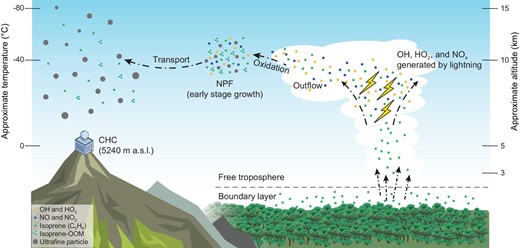
Oxidized organic molecules in the tropical free troposphere over Amazonia
Qiaozhi Zha, Diego Aliaga, Radovan Krejci, Victoria A. Sinclair, Cheng Wu, Giancarlo Ciarelli, Wiebke Scholz, Liine Heikkinen, Eva Partoll, Yvette Gramlich, Wei Huang, Markus Leiminger, Joonas Enroth, Otso Per¨akyl¨a, Runlong Cai, Xuemeng Chen, Alkuin Maximilian Koenig, Fernando Velarde, Isabel Moreno, Tuukka Pet¨aj¨a, Paulo Artaxo, Paolo Laj, Armin Hansel, Samara Carbone, Markku Kulmala, Marcos Andrade, Douglas Worsnop, Claudia Mohr and Federico Bianchi
National Science Review
National Science Review, Volume 11, Issue 1, January 2024, nwad138
Publication Date: May 15, 2023 (online)
Open Access
Copyright © CC BY
© The Author(s) 2023. Published by Oxford University Press on behalf of China Science Publishing & Media Ltd.
Abstract.
New particle formation (NPF) in the tropical free troposphere (FT) is a globally important source of cloud condensation nuclei, affecting cloud properties and climate. Oxidized organic molecules (OOMs) produced from biogenic volatile organic compounds are believed to contribute to aerosol formation in the tropical FT, but without direct chemical observations. We performed in situ molecular-level OOMs measurements at the Bolivian station Chacaltaya at 5240 m above sea level, on the western edge of Amazonia. For the first time, we demonstrate the presence of OOMs, mainly with 4–5 carbon atoms, in both gas-phase and particle-phase (in terms of mass contribution) measurements in tropical FT air from Amazonia. These observations, combined with air mass history analyses, indicate that the observed OOMs are linked to isoprene emitted from the rainforests hundreds of kilometers away. Based on particle-phase measurements, we find that these compounds can contribute to NPF, at least the growth of newly formed nanoparticles, in the tropical FT on a continental scale. Thus, our study is a fundamental and significant step in understanding the aerosol formation process in the tropical FT.
